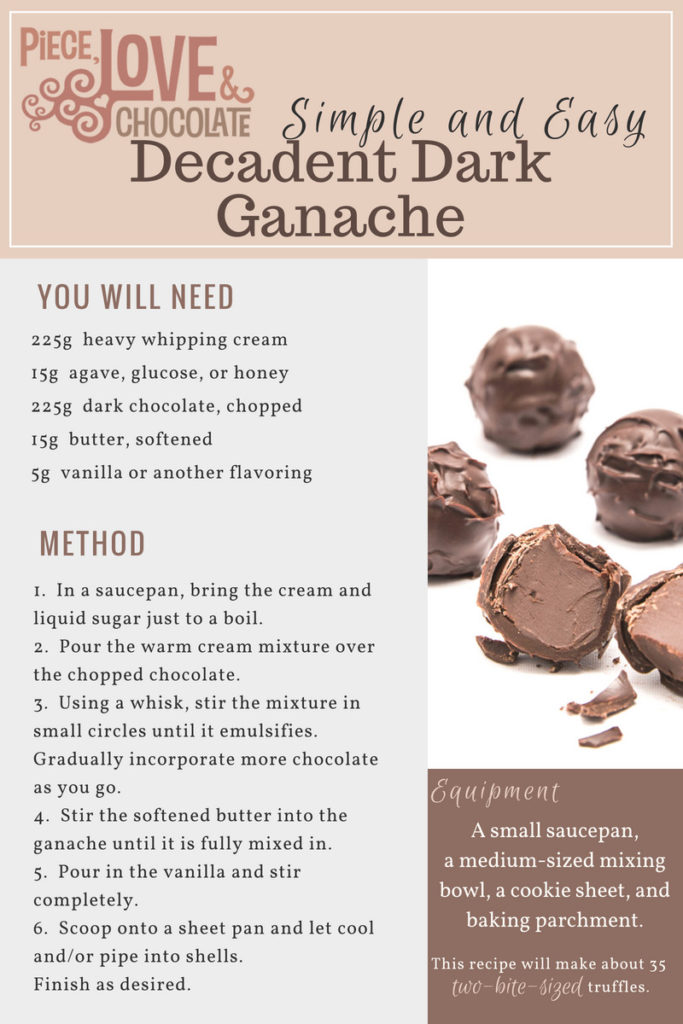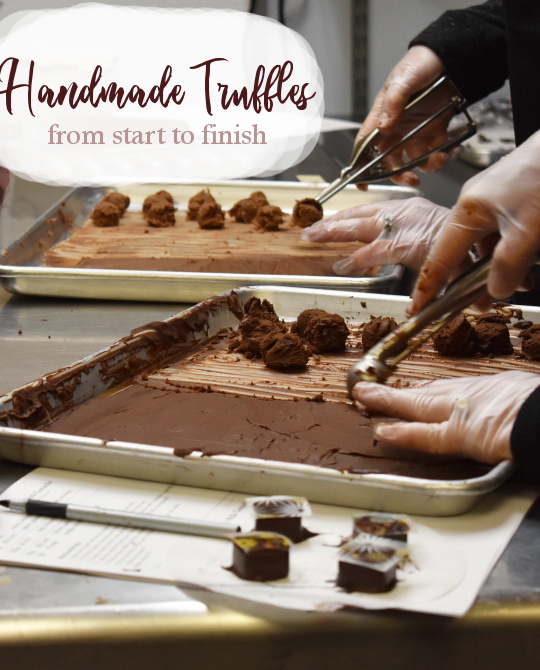
When it comes to pastries and chocolates, ganache has an undeserved reputation for being a tricky subject.
First, say it with me: Gah-nahh-sh. Ganache.
Chocolate ganache is the magical formula at the center of many of our truffles and confections at Piece, Love & Chocolate. Sadly, though, many of our customers and students admit finding ganache intimidating.
This intimidation factor is totally unnecessary. With our classes this season, we want to demystify the culinary arts involved in a chocolate bakery. Since we’ve been teaching classes at PL&C, many of our students have conquered the ganache challenge and found it to be much easier to make than they originally thought. So let’s begin with a peek inside our Truffles and Ganache Techniques class.
What is Ganache?
To begin with, let’s take a look at a truffle.
The shiny outside of the truffle is what we call the shell. For many of our truffles, it’s made of 64% dark chocolate from Ecuador. The shell makes a snap when you bite into, then you’ll taste the soft center.
On the inside, we can have a variety of fillings. At PL&C, our most common fillings are caramel, fruit paste, and ganache.
The ganache carries most of the flavors in the truffle. For example, if you’ve ever wondered where the bright and citrusy flavor of our Key Lime Pie truffle comes from, now you know that it’s not the chocolate, it’s the ganache. Ganache is also responsible for that rich, silky mouth-feel that covers your palette in chocolaty, buttery deliciousness.
In its most basic form, a chocolate ganache is equal parts heavy cream and chocolate. What’s so scary about that?
Well, I wouldn’t call it scary, but ganaches are sensitive to a variety of techniques and which can alter their texture. Temperature, for example, can determine how long it takes a ganache to become firm, or “set-up”. A ganache that is made with really hot cream will take much longer to set up than a ganache made with cooler cream that is around 135-140 degrees f.
There are also a lot of little tweaks and alterations that we can make to a basic ganache recipe. Some ideas include adding purees, increasing the fat content with butter, cocoa butter, or other oils, and adding liquor or reduced beer. All of these additions change the texture and outcome of the ganache in little ways.
PL&C Simple and Easy Decadent Dark Ganache

A Few Tips to Smooth-out Your Ganache-making Process
No chunky ganache. There are a few places that chunky chocolate belongs, like in ice cream and cookies. But chunky chocolate does not belong in your ganache. These chocolate chunks will mean that different parts of the ganache will melt in the mouth at different rates. Try one of these three methods to get rid of chunks:
- If your ganache is in a metal bowl, boil water in your saucepan, and then use it as a double boiler to reheat your ganache.
- If your ganache is in a plastic bowl, pop it into the microwave on low power at 10-second intervals. Stir thoroughly each time, so that you don’t overheat your chocolate.
- Use an immersion blender to blend all the ingredients together.
Pipable Ganache. At PL&C we love to keep our ganache recipes versatile. This means that we can easily adapt a ganache from square-cut truffle recipe into a molded or round truffle recipe.
The recipe that we gave you above will make a stiff ganache. Say you want to pipe your ganache into the middle of a cupcake or between the cookies of a French Macaron, then you will need to make a softer ganache. An easy conversion for this is to increase the liquid content of your formula by 20%.
Reheating a Ganache. There are some instances where a firm ganache will need to be heated or rewarmed so that it will be usable again. Reheating ganaches can be a tricky procedure because adding too much heat too quickly could cause the ganache to break. A broken ganache will mean that the fats clump together, making it look chunky in places and watery in others.
The best way to reheat your ganache is to take it slow. Put it in the microwave for ten-second intervals. If it’s a small amount, then we recommend ten seconds at half power or lower. If it’s a lot of ganache and it’s very cold, you might try thirty-second intervals.
What Else Can You Expect from the Truffles Class?
Ganaches are only the groundwork for what we do in the truffles class. We also teach you to hand-dip truffles in chocolate. Then we make beautiful designs on them with garnishes, using everything from sprinkles to cocoa nibs. Garnishing gets our creativity going and allows our final product to look as great as it tastes.
Join us in class to take your ganache to the next level. We’ll teach you the best techniques on steeping, adding in fruit, and spiking your ganache with a little bit of liquor.
Now it’s your turn! What have you made with ganache? Do you have any tricky ganache questions that need answering?

